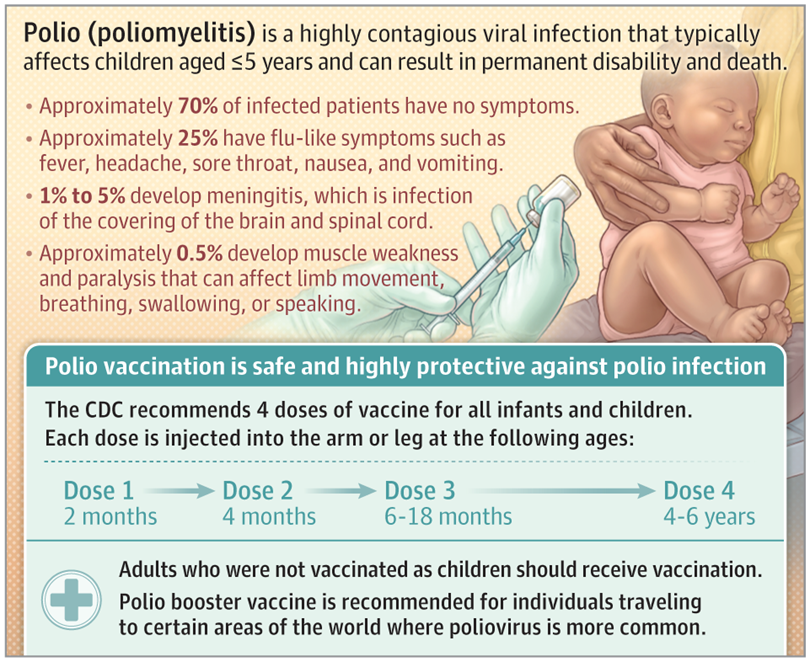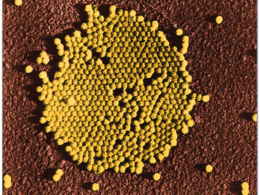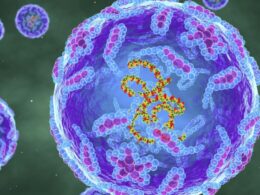The 4 doses (an injection in the arm or leg) are at ages of: 2 months, 4 months, 6 to 18 months, and 4 to 6 years.
This is a republication of the article “What Is Polio?”, with the title above.
JAMA Patient Page
Kristin Walter, MD, MS1; Preeti N. Malani, MD, MSJ2
September 16, 2022
Polio is a serious, highly contagious disease that can affect a person’s nervous system.
- In July 2022, for the first time since 1979, the Centers for Disease Control and Prevention (CDC) reported a case of polio in the US that was not associated with travel outside the country.
- Poliomyelitis, also known as polio, is an infection caused by a virus (poliovirus).
- Polio typically affects children aged 5 years or younger.
- It can result in muscle weakness, permanent disability, and even death.
- Polio is rare in the US because vaccines to protect against polio are given as part of routine childhood immunizations.
Infographic

How Does Poliovirus Spread?
Poliovirus is highly contagious and easily spreads through person-to-person contact.
The virus is typically present in the throat of infected individuals for about 1 to 2 weeks and is expelled in feces (stool) for approximately 3 to 6 weeks, even in people without symptoms.
Poliovirus enters the body through the mouth and is acquired most commonly through contact with stool of an infected individual or through contaminated food or water.
Poliovirus can also be spread through saliva and respiratory droplets.
Who Is at Risk for Polio?
Individuals at risk for poliovirus infection include those who have not been fully vaccinated against polio.
Higher-risk exposure is also associated with travel to countries where poliovirus is circulating in the population.
Signs and Symptoms of Polio
Approximately 70% of people infected with poliovirus have no symptoms.
About 25% develop flu-like symptoms for 2 to 5 days, such as fever, headache, sore throat, nausea and vomiting, stomach pain, and fatigue.
Between 1% and 5% of people infected with poliovirus develop an infection of the covering of the brain or spinal cord (meningitis).
Approximately 1 in 200 infected individuals develop muscle weakness or paralysis, which typically occurs 1 to 3 weeks after poliovirus infection.
Patients with polio may experience weakness or paralysis of muscles involved with limb movement (legs, arms, or both), breathing, swallowing, or speaking.
Polio Diagnosis and Treatment
Patients with symptoms suggestive of polio should have stool specimens collected for viral culture.
Once the virus is isolated in culture, genetic testing can identify the type of poliovirus and help determine its geographic origin.
Any person with symptoms suggestive of polio should seek medical care.
There are currently no specific treatments for polio and no cure for paralysis caused by poliovirus, but physical and occupational therapy can be helpful.
There are currently no specific treatments for polio and no cure for paralysis caused by poliovirus, but physical and occupational therapy can be helpful.
What Is Postpolio Syndrome?
Postpolio syndrome is a noncontagious condition that affects 25% to 40% of people who have had polio approximately 15 to 40 years after their initial infection.
Patients with postpolio syndrome typically experience muscle weakness, joint pain, and mental and physical fatigue.
How Is Polio Infection Prevented?
Vaccination is safe and highly protective against polio.
The CDC recommends that all infants and children receive 4 doses of inactivated polio vaccine (an injection in the arm or leg) at ages
- 2 months,
- 4 months,
- 6 to 18 months, and
- 4 to 6 years.
People who were not vaccinated during childhood should receive polio vaccinations.
Individuals who were vaccinated during childhood and are traveling to areas with circulating poliovirus should receive a polio vaccine booster prior to travel.
How Is Polio Infection Prevented? Vaccination is safe and highly protective against polio.
The CDC recommends that all infants and children receive 4 doses of inactivated polio vaccine (an injection in the arm or leg) at ages of: 2 months, 4 months, 6 to 18 months, and 4 to 6 years.
Originally published at: https://jamanetwork.com
About the authors & affiliations
Kristin Walter, MD, MS1;
Preeti N. Malani, MD, MSJ2
1 Senior Editor, JAMA
2 Deputy Editor, JAMA
The JAMA Patient Page is a public service of JAMA.
The information and recommendations appearing on this page are appropriate in most instances, but they are not a substitute for medical diagnosis.
For specific information concerning your personal medical condition, JAMA suggests that you consult your physician.
RELATED ARTICLES








